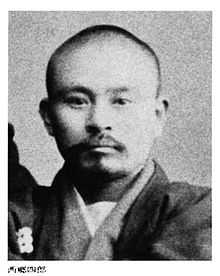Shiro Saigo
| Saigō Shirō 西郷四郎 | |
|---|---|
 | |
| Born |
February 4, 1866 Aizu Wakamatsu, Japan |
| Died | December 22, 1922 (aged 56) |
| Native name | 西郷四郎 |
| Nationality |
|
| Style | Judo, Daitō-ryū Aiki-jūjutsu |
| Teacher(s) | Saigō Tanomo Kanō Jigorō |
| Rank | Judo: 6th Dan |
Shiro Saigo (西郷四郎 Saigō Shirō, February 4, 1866 – December, 1922) was one of the earliest disciples of Judo. Saigo, together with Tsunejiro Tomita, became first in history of judo to be awarded black belt grade by the founder of judo Jigoro Kano, who established the kyu-dan ranking system.[1]
Biography
Shiro Saigo was born in Feb 4, 1866 in Aizuwakamatsu, in the Fukushima Prefecture of Japan, the third son of a samurai, Shida Sadajiro. In 1882, Saigo moved to Tokyo and in August of that year, he enrolled at the Kōdōkan, becoming Jigoro Kano's second student.[2] In 1883, along with Tsunejiro Tomita, he became one of the first two to be awarded yudansha rank in any martial art. Saigo was responsible for an early surge of popularity for Kodokan Judo, when he demonstrated its superiority by easily defeating a much larger opponent:
| “ | In the years 1885 and 1886, the first foreigners joined the Kami Niban-cho dojo to learn judo. Among them were two American brothers named Eastlake. The elder, weighing some 100 kilograms, was an English language teacher, and the younger, of much slighter build, was a trading house employee. Though Shiro Saigo was far shorter and lighter than the elder Eastlake, Saigo was able to throw the hefty American with considerable ease. Because word quickly spread of his mastery over the big foreigners, Saigo became something of a celebrity. Non-judo people in particular were most impressed at the spectacle of such a small man so easily throwing a much bigger opponent, so much so that Saigo's exploits induced many others to take up training in judo. Thus, thanks to the prowess of our superstar, the number of applicants for Kodokan membership suddenly surged.[3] | ” |
Saigō took part in the 1886 Tokyo Police tournament in which students of Kano demonstrated their superiority over the Yōshin-ryū jūjutsu.[4] In 1890, Saigo left the Kōdōkan and retired to Nagasaki, devoting the rest of his life to Kyūdō.[5]
The main character in Akira Kurosawa's 1943 directorial debut, Sugata Sanshirō, was based on Shiro Saigo, the film being based on the novel of the same name written by Tsunejiro Tomita's son, Tsuneo.
Four Guardians of the Kōdōkan
When Jigoro Kano began to develop Judo from Jujutsu, his efforts met with opposition from Jujutsu practitioners. However, Kano drew a loyal following that included exceptional fighters. Hence the term "Four Guardians of the Kōdōkan" came into existence referring to Shiro Saigo along with Yamashita Yoshiaki, Yokoyama Sakujiro, and Tsunejiro Tomita.[6]
References
Bibliography
- Kano, Jigoro (2008), Watson, Brian N., ed., Judo Memoirs of Jigoro Kano, Victoria, BC: Trafford Publishing
- Linhart, Sepp; Fruhstuck, Sabine (June 1998). The Culture of Japan As Seen Through Its Leisure. State University of New York Press. p. 85. ISBN 0-7914-3791-4.
- Stevens, John; Shirata, Rinjiro (1983), Aikido, the way of harmony, Boulder, Colorado: Shambhala Publications, Inc.
- Takahashi, Masao (2005), Mastering Judo, Champaign, Illinois: Human Kinetics